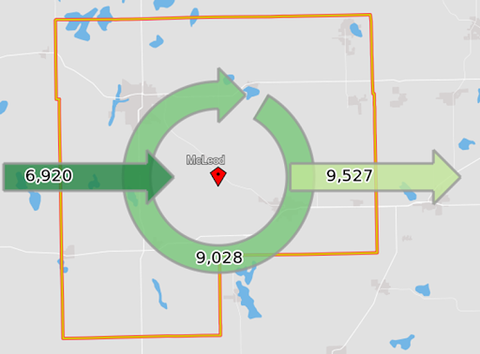Ben Winchester is a rural sociologist with Extension.
I am a glass-full kind of guy, especially when it comes to what is happening across our rural communities. The dominant narrative of doom, gloom, demise and death is based largely on stereotypes or trends that happened to our towns over a half-century (or more) ago. That is, our kids keep leaving, hollowing out our undesirable towns and leaving only graying residents to fend for themselves in the middle of nowhere.
Then one day, these towns will die, they say.
I believe our rural communities are better poised for the future than ever before. But rather than each community fending for themselves, we must better recognize the aspects of regional, rural living and the relationships between our places that are more important than ever. Economically, we don’t all work in town. In fact, just 51% of residents across Minnesota work in the same county as their home.
For example, every day 6,920 people drive into McLeod County to work, while at the same time 9,527 drive out. Just 9,028 people (57%) both work and live in the county. These regional employment patterns are not unique — they are replicated across the country.
There have also been well-documented shifts in the retail sectors of our small towns, where the impacts of globalization and regionalization have left these jobs shifting to regional centers across Minnesota. Big box retailers and their negative influence upon the retail sectors of towns surrounding their placement have been part of rural life now for over thirty years. Today we see new types of retail blooming in places that were closed. Just because things look different today does not mean we are dead.
We may be led to believe social life is dying and people don’t want to be involved anymore, but this is not true. New groups are being created every year to provide civic or social structures — like taking disabled veterans fishing or protecting our lakes. Across McLeod County, there are 258 nonprofits in 2020, up from 211 in 2000. These nonprofits are sources of over $213 million in revenue and hold over $410 million in assets.
At the same time, like with jobs, people cross the county lines to participate. This has been one of the greater shifts in social life, from place-based groups to interest-based groups. These interest-based organizations can span multiple counties into regions — for example, the West Central Minnesota Snowmobile Association. There are people involved from all over the region in this group.
The regionality of our lives is part and parcel of rural living. No town is a one-stop shop anymore. We live, work, shop and play in a fairly large region.
To emphasize this we conducted an exercise in February with participants in the McLeod for Tomorrow leadership program. This was a simplified version but we asked each participant to mark their home with a dot, then identify the boundaries around which they, in the past year, went to shop and eat out. This is not the prettiest chart but it is powerful in the affirmation of the regional model. Notice how far out from the county people travel during the course of everyday life?
We can do many exercises like this to find out about all the cool things going on around us. We must move past the parochial model that “we must have it all” in our town. Again, the one-stop-shop town is long gone. For example, say I am looking to moving to town X, and I run into the Mayor:
Me: "I am looking at moving to your town!"
Mayor: "Super! You will love it here, we have a fine restaurant, a full k-12 school, and a great C-store/hairstylist/car sales."
Me: "I am also looking at moving to town Y down the road."
Mayor: "Oh, there’s nothing going there, WE have it all!"
What just happened there? If we can’t talk nicely about our neighbor down the road we really do live in the middle of nowhere. So I ask, Mayor, how do you truly market your town if you don’t know what’s going on around you?
This presents a challenge then: How can we make local decisions while at the same time respecting the regional reality of our lives? Our county boundaries are not some form of natural population delineations; they were drawn during the time of horse and buggy. We must recognize that the region is the primary geography of interest and when we view our rural areas in this light we are more diverse economically, socially, and demographically than ever before. In fact, we live in the Middle of Everywhere.
A version of this article, Living in the Middle of Everywhere, originally appeared on McLeod for Tomorrow's website.


